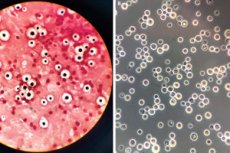New publications
Scientists will study the "Chernobyl" fungus
Last reviewed: 02.07.2025

All iLive content is medically reviewed or fact checked to ensure as much factual accuracy as possible.
We have strict sourcing guidelines and only link to reputable media sites, academic research institutions and, whenever possible, medically peer reviewed studies. Note that the numbers in parentheses ([1], [2], etc.) are clickable links to these studies.
If you feel that any of our content is inaccurate, out-of-date, or otherwise questionable, please select it and press Ctrl + Enter.

NASA has announced the need to study the black mold found in the closed area of Chernobyl.
During one of the regular inspections of the fourth power unit of the Chernobyl nuclear power plant, the robot discovered a strange dark substance of unknown origin on the inside of the sarcophagus. The sampled material was sent for examination, which later showed that it was a specific mold with a high melanin content. Scientists suggested that the fungus had deliberately “darkened” in order to protect itself from radiation. Before this, employees of the Institute of Microbiology and Virology of the National Academy of Sciences of Ukraine in Kyiv had been studying fungal melanin-containing colonies found in soil samples near the sarcophagus for about fifteen years. As it turned out, the fungi not only resist the harmful effects of radioactive rays, but also accelerate their growth and development under ionizing influence.
NASA specialists have also expressed interest in studying the "Chernobyl" fungus, which is capable of absorbing radioactive radiation. Moreover, the American Space Agency will conduct a series of experiments with the fungus on board the ISS in the future.
A curious fungus in the form of black mold was discovered on the surface of the walls of an abandoned power unit of the Chernobyl nuclear power plant. Ukrainian specialists had previously described this discovery, and it happened five years after the tragic accident – that is, in 1991. Soon after, scientists discovered the specific abilities of the fungal flora: it was able to absorb radioactive radiation.
A subsequent research team of world experts was able to prove that types of melanin-containing fungi such as Cryptococcus neoformans, Cladosporium sphaerospermum and Wangiella dermatitidis increase biomass and accumulate acetate primarily in conditions with radioactive levels five hundred times higher than normal. Biology experts note that this means that fungi transform the flow of gamma rays into a chemical flow in much the same way that plants use photosynthesis to produce oxygen from carbon dioxide.
Representatives of the American Space Agency assume that this process can be used to produce bioactive products that protect against radioactive solar radiation, or to use it at other nuclear power plants. In addition, it is possible to use the fungus as an energy accumulator, which can become a biological analogue of solar batteries.
It is not yet known when exactly the mold will be assembled and sent aboard the International Space Station. However, there is information that such an expedition has been planned since 2016.
Information provided on the website
